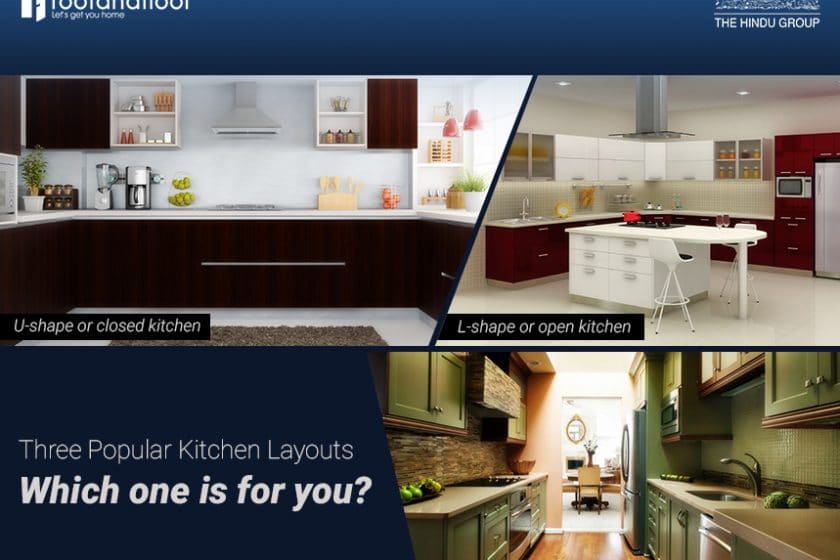How to use the workspace in your kitchen? It is the most important aspect that requires consideration when determining the right layout for your kitchen. Do you want an open or closed concept? Do you want a design with a separate storage room? Which kitchen layout will suit your cooking style? Here are the pros and cons of the three most popular kitchen layouts. Find out which one is for you –
U-shape or closed kitchen
The U-Shaped kitchen, also known as closed kitchen, is usually closed from three sides and is common in smaller residences such as apartment buildings.
Pros – Since these types of kitchens use the three sides of the wall for making cabinets, they are great for storage. It will be easier to keep your kitchen organised as you can allot a storage location for each item.
If you love privacy, the U-shaped kitchen is best for you as it will keep the kitchen separate from other areas of the home.
Cons – If you are someone social who prefers talking or watching TV while cooking, the U-shaped kitchen might feel cramped.
Verdict – If your kitchen is really tiny, the U-shaped kitchen can provide you with lots of storage spaces. However, if you have young children at home who need constant supervision (even when you are cooking), the U-shaped kitchen is not a good idea.
L-shape or open kitchen
As the name suggests, the L-shaped kitchen consists of perpendicular countertops on two adjoining walls, forming an L-shape. These types of kitchens are open from two sides and are very flexible in their layout.
Pros – The L-shaped or open kitchen is ideal for open cooking and socialising and can make the kitchen the central hub of the home. Making an island is easiest in the L-shaped kitchen as you can include adjacent area too, thereby extending your work zone.
An open kitchen provides the correct balance between counter and storage space, especially when they include an island. You can play with different kitchen styles and choose different styles of work zones instead of the traditional L-shape.
Cons – You will always have to keep the kitchen organised as the work area in the L-shaped kitchen is open. Secondly, in the absence of an island, you might feel a bit of a crunch. If you are on a tight budget, this added expense may not suit you.
Verdict – Not recommended if you need more workspace or cannot afford an island.
Galley kitchen
The galley kitchen is mid-way between the U-shaped and L-shaped kitchen. In this type of kitchen, two parallel counters are placed with a pass-way in between. You may choose to have closed walls, partially open walls or an island as per your requirement of preference.
Pros – The galley kitchen makes for efficient cooking zones. It provides flexibility and versatility. They maximise the space and can provide ample workspace. Unlike the U-shaped kitchen, the cabinetry here is fully functional and accessible. You don’t need to have a separate island and is budget-friendly.
Cons – The size will definitely be smaller than a U-shaped kitchen. If you are looking for supersize kitchen with lots of counter and storage space, you might find the area insufficient.
Verdict – Works well, if you are looking to maximise space in a small kitchen. Not for someone who is looking for lots of storage area.
In addition to the above-mentioned layouts, there are many different types of kitchen designs that don’t fit into any of the above layouts.
A customised kitchen that is a hybrid between open and closed is a new rage among house owners. These custom cabinets can be built in any shape, size and measurements to fit your kitchen’s unique layout.
This article was originally published on www.thehindu.com



One comment